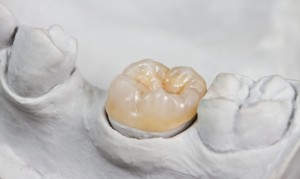A dental crown is a cap that is placed over the tooth to help protect it. It is shaped like your regular teeth and is used to not only improve your mouth’s appearance but to save the remaining part of your natural tooth. Your new crown will be cemented into place to fully encase the visible portion of your tooth that is above the gum line.
What Does It Do?
Crowns are used after dental procedures like root canals to help protect the remaining part of your tooth. They are used to protect weak teeth, hold together cracked teeth, restore broken teeth, cover large fillings, hold dental bridges in place, cover misshapen or discolored teeth, cover implants, or to modify your teeth cosmetically. Your dentist may talk to you about several types of crowns, but there are three popular materials for your dental crown: metal, porcelain fused to metal, and ceramic.
Metal Alloy
Metal crowns contain non-noble metals to provide strength to your tooth and crown. This type of crown is resistant to corrosion and is gentle on opposing teeth. Unlike other types of crowns, metal crowns do not blend in with your other teeth so this crown will be visible depending on where it is situated in your mouth. If you have metal allergies, this type of crown should not be used. Patients have experienced hot and cold sensitivity with this crown. Because of the material, it could inhibit dental x-rays, making it harder to diagnose further problems.
Ceramic
These ceramic crowns offer the most aesthetic appeal. They are the same color as your natural teeth and feel the same. For people who are allergic to the metals in the metal crown, this material is a great alternative. Ceramic crowns are very strong and durable. But they could be made from different materials depending on the supplier of this crown.
Porcelain Fused to Metal
Porcelain fused to metal (PFM) is just as strong and durable as metal crowns but are as aesthetically pleasing as ceramic crowns. Your tooth may have a bit of the metal showing through the bottom of the crown, which could ruin the aesthetic appeal of your crown. These crowns have porcelain on the top but metal underneath, which means they are not as durable as regular metal crowns. Because this crown is also made of metal, your dentist will not be able to examine the tooth thoroughly with an x-ray for further and future damage.
For more information on your best option for your crown, contact your Catonsville Dental Care dentist today!
Leikin & Baylin Dental Care of Catonsville
If you have questions about the health of your child’s teeth, or your little one is experiencing one of these childhood dental problems, let our friendly and professional staff help restore your dental health. Call today at 410-747-1115, or submit any questions by visiting CatonsvilleDentalCare.com.
Disclaimer: The writer of this article is not a medical professional. Information contained herein has been collected from sources believed to be reliable, and every precaution has been taken to ensure its accuracy. The information provided here is for general informational purposes only, and should not be used as a substitute for professional medical care.

